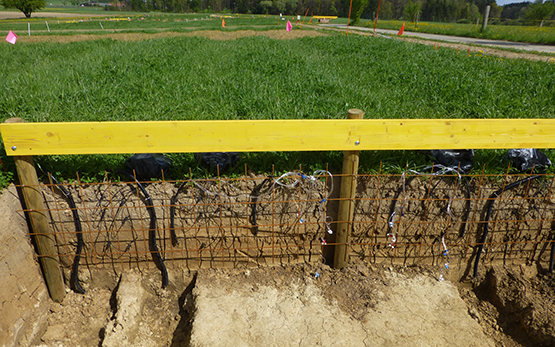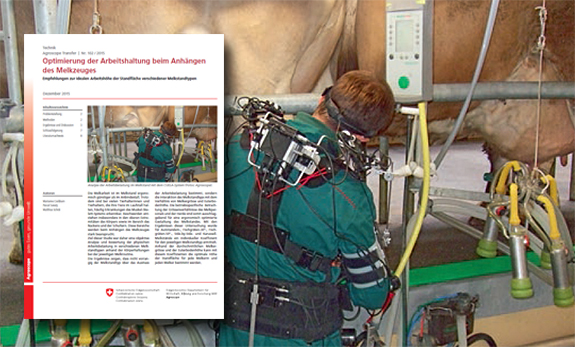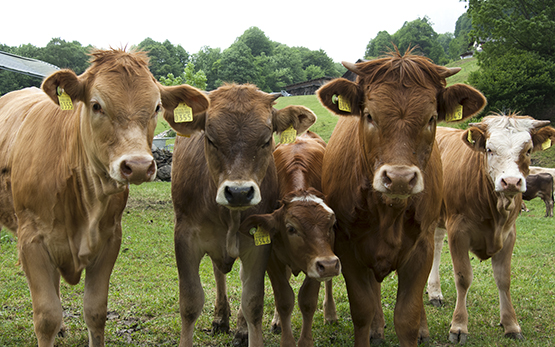Palumbo F., Trevisi P., Correa F., Bee G., Girard M.
Increasing the level of hemicelluloses in the lactation diet affects the faecal microbiota of sows and their piglets without affecting their performances.
Animal Microbiome, 6, 2024, Artikel 68.
Girard M., Palumbo F., Fleuti C., Silacci P., Bee G.
The water solubility of dietary fibers affects sow farrowing duration, colostrum production and offspring growth.
In: Spring Conference Animal Nutrition 2024. 23rd May, Hrsg. ETH, Lindau (CH). 2024, 11-12.
Vasa S., Girard M., Gardiner G. E., O’driscoll K., Bee G., Lawlor P. G.
Feeding a gestation diet to sows in early lactation and liquid creep feeding of suckling pigs.
In: 75th EAAP Annual Meeting. 3 September, Hrsg. EAAP, Florence (IT). 2024, 610.
Manoni M., Altomare A., Nonnis S., Ferrario G., Mazzoleni S., Tretola M., Bee G., Tedeschi G., Aldini G., Pinotti L.
Preliminary investigation on the impact of salty and sugary former foods on pig liver and plasma profiles using OMICS approaches.
Scientific Reports, 14, 2024, Artikel 19386.
Lautrou M., Bee G.
Estimation de l’efficacité d’utilisation des acides aminés à partir de données de composition chimique de porcs en croissance.
In: Journée de la production animale. 26 septembre, Hrsg. Agroscope / AGRIDEA, Grangeneuve. 2024.
Lautrou M., Bee G.
Estimating the efficiency of amino acid use using chemical composition data from growing pigs.
In: 75th EAAP Annual Meeting. 4 September, Hrsg. EAAP, Florence (IT). 2024.
Hu D., Ollagnier C., Hofer A., Girard M., Gutzwiller A., Bee G., Neuenschwander S.
The genetic resistance of sows to Escherichia coli F4 adhesion reduces their response to a vaccine containing F4 fimbriae but does not affect the preweaning performance of their susceptible piglets.
Schweizer Archiv für Tierheilkunde, 166, (9), 2024, 451-458.
Tretola M., Mazzoleni S., Bee G., Silacci P., Pinotti L.
Replacing cereal with ultra-processed foods in pig diets does not adverse gut microbiota, L-glutamate uptake, or serum insulin.
The Journal of Nutrition, 154, (9), 2024, 2717-2731.
Tretola M., Bee G., Silacci P.
Electrogenic transport of amino acids and glucose differs between jejunum and ileum of female and castrated male finishing pigs.
Italian Journal of Animal Science, 23, (1), 2024, 618-628.
Tretola M., Mazzoleni S., Silacci P., Dubois S., Proserpio C., Pagliarini E., Bernardi E.M., Pinotti L., Bee G.
Sustainable pig diets: Partial grain replacement with former food products and its impact on meat quality.
Journal of Animal Science, 102, 2024, 1-15.
Mazzoleni S., Tretola M., Luciano A., Lin P., Pinotti L., Bee G.
Sugary and salty former food products in pig diets affect energy and nutrient digestibility, feeding behaviour but not the growth performance and carcass composition.
Animal, 17, (12), 2024, 1-10.
Mbuthia J., Kasper-Völkl C., Zenk M., Bee G., Metges C., Das G.
Prediction of piglet survival based only on birth weight or within-litter birth weight variability.
In: Book of Abstracts of the 74th Annual Meeting of the European Federation of Animal Science. 26 August - 1 September, Hrsg. EAAP European Federation of Animal Science, Lyon (FR). 2023, 214.
Girard M., Correa F., Palumbo F., Silacci P., Bee G.
The dietary fibre solubility in the maternal diet does not affect the muscle development of piglets.
In: 74th Annual Meeting of the European Federation of Animal Science (EAAP). 29 August, Lyon. 2023, 465.
Lin P., Bee G., Neuenschwander S., Girard M.
Performances, milk quality, and piglet growth in lactating sows fed former food products.
In: 74th Annual Meeting of the European Federation of Animal Science (EAAP). 28 August, Lyon. 2023, 341.
Pinotti L., Ferrari L., Fumagalli F., Luciano A., Manoni M., Mazzoleni S., Govoni C., Rulli M.C., Lin P., Bee G., Tretola M.
Review: Pig-based bioconversion: The use of former food products to keep nutrients in the food chain.
Animal, 17, (2), 2023, 1-7.
Ewaoluwagbemiga E., Bee G., Kasper-Völkl C.
Genetic analysis of protein efciency and its association with performance and meat quality traits under a protein-restricted diet.
Genetics Selection Evolution, 55, 2023, 1-16.
Tretola M., Bee G., Dohme-Meier F., Silacci P.
Review: Harmonized in vitro digestion and the Ussing chamber for investigating the effects of polyphenols on intestinal physiology in monogastrics and ruminants.
Animal, 17, (5), 2023, 1-46.
Girard M., Palumbo F., Correa F., Bee G.
Effet de la solubilité des fibres alimentaires chez la truie sur le déroulement de la mise bas, la qualité du colostrum et la croissance des porcelets.
In: 55èmes Journées de la Recherche Porcine. 31 janvier, Hrsg. IFIP, INRAE, Saint Malo. 2023, 243-244.
Palumbo F., Bee G., Trevisi P., Girard M.
Decreasing the level of hemicelluloses in sow’s lactation diet affects the milk composition and post-weaning performance of low birthweight piglets.
Italian Journal of Animal Science, 22, (1), 2023, 250-262.
Palumbo F., Girard M., Correa F., Bee G., Trevisi P.
A workflow to study the microbiota profile of piglet’s umbilical cord blood: from sampling to data analysis.
Animal Open Space, 2, 2023, 1-5.








